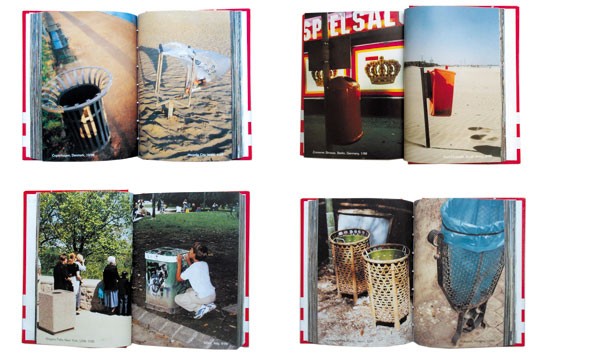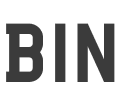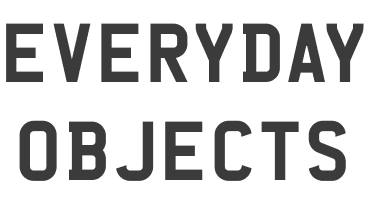- Manufacturer: Santa & Cole
- Designer: Gonzalo Milà Valcárcel & Martina Zink
- Material: polyethylene
- Dimensions: 122 × 63 cm
- www.santacole.com
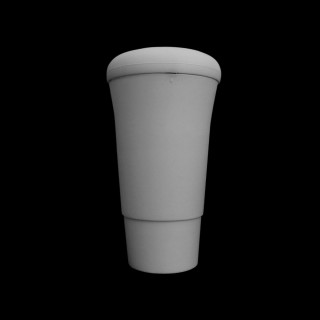
Index
- Everyday Objects For 23 years now, Santa & Cole has lived for industrial design, an art consisting of focusing on everyday objects in order to seek a better user exper
- Features [The bin] can be well fixed in the sand, is stackable and easy to maintain. [...] It meets all of the necessary requirements for use at the beach: lar
- Designer Gonzalo Milá […] decides to work on his own in order to create what he likes most, furniture, and to invent 'little things that surprise every day wit
- Manufacture Rotationally-moulded polyethylene is 100% recyclable. The principle of rotational moulding of plastics is simple. Basically the process consists of in
- Materials Polyethylene or polythene (IUPAC name polyethene or poly(methylene) is the most widely used plastic, with an annual production of approximately 80 mil
- The Beach The beaches of Barcelona are installed with pairs of waste disposal bins [Bina] on the sand, which permit two types of selective waste collection: tha
- Typologies There are many reasons why traveling is so great. Change, adventure, the pleasure gained from new impressions of people, culture, communication, inter
For 23 years now, Santa & Cole has lived for industrial design, an art consisting of focusing on everyday objects in order to seek a better user experience, thereby leading us to reflect upon material culture.
Santa & Cole [does its] utmost to generate, contract, protect and spread knowledge, expressed through physical products with fine design, the fondly remembered 'Gute Form' of the Bauhaus: constructive solidity, aesthetic sobriety and functional quality, a trilogy which becomes even a moral rule, especially in these times of such material waste on a planetary scale.
[The bin] can be well fixed in the sand, is stackable and easy to maintain. [...] It meets all of the necessary requirements for use at the beach: large capacity, easy maintenance, a lid that can be quickly moved, with a lock to protect it against vandalism, solid placement in the sand, since the last 30 centimeters of the body are buried in the sand, and are filled with sand before the plastic bag is placed inside, thus achieving simple and perfect placement that can be piled up in order to facilitate storage at the end of the summer season.
The plastic body allows for the litter bin to be coloured en masse and facilitates personalization or adaptation to the surroundings. The lid includes a space upon which the name and shield of the municipality can be engraved.
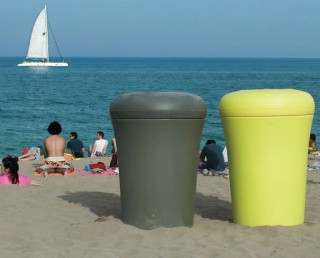
Gonzalo Milá […] decides to work on his own in order to create what he likes most, furniture, and to invent 'little things that surprise every day without gratuitousness, starting from new technologies or from applying traditional technologies to new concepts.'
Rotationally-moulded polyethylene is 100% recyclable.
The principle of rotational moulding of plastics is simple. Basically the process consists of introducing a known amount of plastic in powder, granular, or viscous liquid form into a hollow, shell-like mould. The mould is rotated and/or rocked about two principal axes at relatively low speeds as it is heated so that the plastic enclosed in the mould adheres to, and forms a monolithic layer against, the mould surface. The mould rotation continues during the cooling phase so that the plastic retains its desired shape as it solidifies. When the plastic is sufficiently rigid, the cooling and mould rotation is stopped to allow the removal of the plastic product from the mould. At this stage, the cyclic process may be repeated.

Polyethylene or polythene (IUPAC name polyethene or poly(methylene) is the most widely used plastic, with an annual production of approximately 80 million metric tons.
Widespread use in the modern world
- It is the highest tonnage agricultural chemical (commercially, glass greenhouses have been replaced by poly-tunnels).
- Polyethylene is now the major insulator for electric cables.
- Several companies are now producing spun polyethylene fibres.
- Ultra-high molecular weight polyethylene (UHMWPE) is the major material used in artificial replacement hip joints.
Applications
Liquid food packaging, industrial containers, fuel tanks, blown and cast film stretch wrap, packaging, bags, multilayer blown and fill & seal bags, extrusion coating, extrusion coating film, toys.
Statistics
- 60 million tonnes of polythene produced worldwide every year
- 13 billion bags handed out to shoppers in Britain every year
- £424.1m turnover in 2007 of British Polythene Industries plc
- 400 plastic bags used per adult in the UK every year
- 1 million plastic bags used worldwide every minute
- 5 pence per plastic bag charged by Marks & Spencer
- 70,000 tonnes of plastic waste recycled annually by British Polythene Industries plc.
Environment
The wide use of polyethylene makes it an important environmental issue. Though it can be recycled, most of the commercial polyethylene ends up in landfills and in the oceans (notably the Great Pacific Garbage Patch). Polyethylene is not considered biodegradable, as it takes several centuries until it is efficiently degraded. In May 2008 Daniel Burd, a 16 year old Canadian, won the Canada-Wide Science Fair in Ottawa after discovering that Sphingomonas, a type of bacteria, can degrade over 40% of the weight of plastic bags in less than three months. The applicability of this finding is still a matter for the future.
The beaches of Barcelona are installed with pairs of waste disposal bins [Bina] on the sand, which permit two types of selective waste collection: that of containers, which represent approximately 75% of the total waste collected and which must be deposited in the yellow bins, and that of other waste products which must be deposited in the grey bins. There are also containers for selective collection and can crushing machines on the Passeig Marítim. At information points, beach users may request plastic ashtrays to dispose of cigarette butts, as well as dried fruit shells, chewing gum and other small waste products.
Sanitation
The cleaning and maintenance of the beaches in Barcelona is, without doubt, one of the most important parts of their management. Throughout the year, the City Council, in collaboration with other agencies, carries out cleaning and maintenance tasks on the city's beaches and the Passeig Marítim, with a team of over 200 people. Beach cleaning operations are organized according to the influx of users. For this reason, the frequency of cleaning operations and the volume of human and material resources increase during the bathing season, especially between the months of June and August. [...] The cleaning of the sand in order to ensure its quality is a task carried out all year round, by means of a manual and mechanical process which sifts the sand to a depth of 30cm to eliminate organic and inorganic surface material, as well as sand grains larger than 2cm. This operation also serves to oxygenate the top layer of sand and to contribute to the elimination of any pathogenic bacteria or fungi that might be present.
Awards
The Blue Flag is an eco-label awarded every summer by the Foundation for Environmental Education (FEE), which accredits water and sand quality, safe access, the absence of circulating vehicles, adequate services and signposting and the presence of environmental education campaigns and activities. In 2006, the Blue Flag was awarded to the beaches of Barceloneta, Nova Icària, Bogatell, Mar Bella and Nova Mar Bella.
There are many reasons why traveling is so great. Change, adventure, the pleasure gained from new impressions of people, culture, communication, interest in the variety of the world. Because on the spot, everything is excitingly different. This difference often manifests itself in quite banal everyday ways - it's the little difference that tells you that you're somewhere else.
So here the spotlight is on the litter bin, the trash can - often overlooked in spite of its very public appearance and general usefulness. These photographs of litter bins were taken over a period of many years, simply for the pleasure of observation, experience, documentation, and taking photographs. At the same time, they also remind me of having been in a particular place at a particular time. And to this was added the pleasure of collecting, so that today, with the contributions from family and friends, my collection contains well over 1000 photographs of litter bins in more than thirty countries on every continent.
This book is arranged by design feature, for example the type of fastening, purpose, opening, shape, volume, so the result is a kind of flipbook: the bins change in the course of the book from square to round, from top-loaders via baskets to free-standing and hanging versions.
The more love expended on litter bins, the more the container itself becomes an object worth looking at. But the minimalist version has its charms too. There is no limit to the variety of shapes, materials and colors. Viewed side by side, the objects develop a very special dynamic and reveal interesting facts about their cultural context. And so there arises a global typology of the trash can, a small litter-bin universe, which is now presented to the reader as a travel guide.
